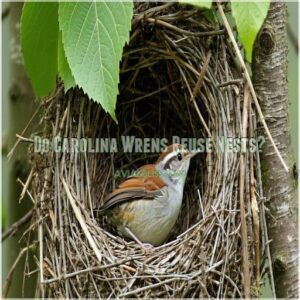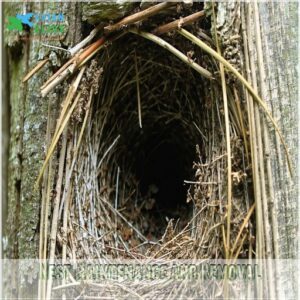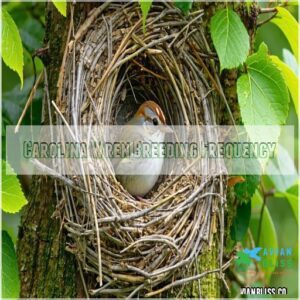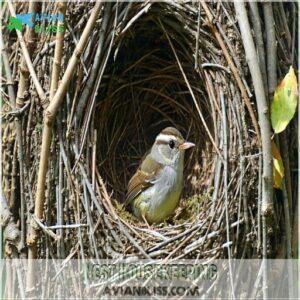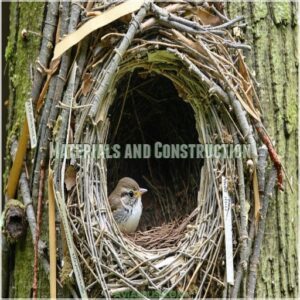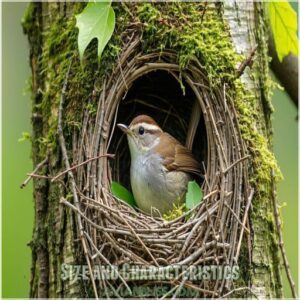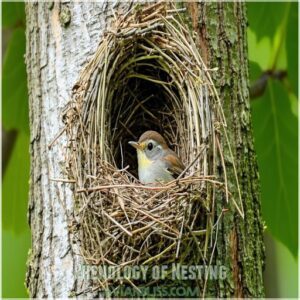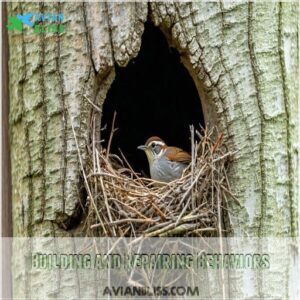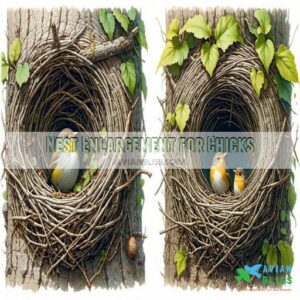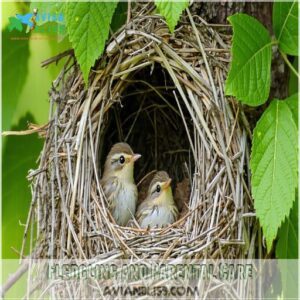This site is supported by our readers. We may earn a commission, at no cost to you, if you purchase through links.
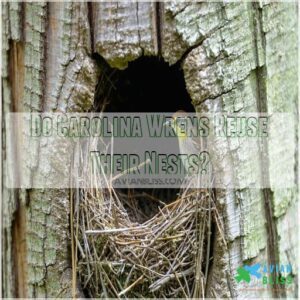 Wondering if Carolina wrens reuse their nests? You’ll be surprised!
Wondering if Carolina wrens reuse their nests? You’ll be surprised!
These crafty birds typically build fresh nests for each breeding cycle, rarely recycling last season’s home.
While they might reuse a structurally sound nest within a single breeding season, multiple pairs often share the same nesting site sequentially. Factors like parasite presence, nest damage, and seasonal timing influence their decision.
They’ll construct 2-3 nests annually, each carefully crafted with moss, twigs, and sometimes quirky human-made materials.
Nest building’s a collaborative dance between male and female wrens, ensuring a cozy, camouflaged sanctuary for their 4-6 eggs. Ready to learn more about these architectural avian experts?
Table Of Contents
- Key Takeaways
- Do Carolina Wrens Reuse Their Nests?
- Do Carolina Wrens Reuse Nests?
- Nest Maintenance and Removal
- Carolina Wren Breeding Frequency
- Nest Housekeeping
- Nest Location Preference
- Nest Appearance
- Phenology of Nesting
- Nest Construction Process
- Fledgling and Parental Care
- Frequently Asked Questions (FAQs)
- Will wrens use the same nest twice?
- Should I remove old wrens nest?
- Do baby Carolina Wrens come back to the nest?
- How many times a year do Carolina Wrens nest?
- Will a wren use the same nest twice?
- How many times a year do Carolina wrens nest?
- Should I clean out the Wren House?
- How often do Carolina wrens build new nests?
- Do Carolina wrens build nests in the same place?
- What do Carolina wren nests look like?
- Conclusion
Key Takeaways
- You’ll rarely see Carolina wrens reuse their exact same nest from one breeding season to the next. Instead, they’ll meticulously build two to three fresh nests annually, prioritizing their family’s health and safety.
- They’re strategic nest builders who will construct new homes in similar locations, carefully selecting sheltered spots like tree cavities, mailboxes, or garden tools to protect their vulnerable chicks.
- You’ll find their nest maintenance incredibly detailed—they’ll actively remove debris, manage parasites, and even enlarge their nests to accommodate growing chicks throughout their breeding season from March to October.
- These resourceful birds collaborate during nest construction, with males gathering materials and females weaving intricate, well-camouflaged homes that blend seamlessly into their surrounding environment, showcasing their remarkable adaptability.
Do Carolina Wrens Reuse Their Nests?

Carolina wrens frequently embrace nest reuse, displaying remarkable practicality in their nesting habits.
By reusing existing nests, particularly those with favorable nest locations, these resourceful birds save precious energy and increase the chances of successful breeding.
When conditions are favorable, these resourceful birds save precious energy by returning to existing nests, provided they’re structurally sound and free from parasites.
Studies show this behavior promotes successful breeding cycles.
Do Carolina Wrens Reuse Nests?
You’ll find that Carolina wrens don’t typically reuse their nests from one season to the next, preferring to construct fresh nests for each breeding cycle.
While they might return to the same general location if it proved successful, these resourceful birds will gather new materials and build an entirely new nest structure, ensuring ideal conditions for their eggs and chicks.
Frequency of Nest Reuse
When studying carolina wren nest reuse rates, researchers have observed fascinating patterns in their nesting habits.
These resourceful birds demonstrate remarkable efficiency through their nest reuse frequency, often constructing new nests in the same general location, and sometimes even utilizing existing nest boxes.
These existing nest boxes can either be in sheltered spots near vegetation or human structures, and sometimes are even built in the same nest site for consecutive broods.
Factors affecting reuse include structural integrity and seasonal timing.
Reuse by Different Wren Pairs
Different pairs of wrens have been observed sharing the same nesting sites, showcasing interesting patterns of nest reuse frequency.
You’ll find that these resourceful birds don’t always stick to pair fidelity regarding nesting locations.
Resource competition rarely becomes an issue, as most carolina wren nest reuse happens sequentially rather than simultaneously.
While studying wren nest reuse, researchers have documented multiple pairs successfully using the same structure throughout a season. This behavior minimizes the energy spent on construction, though interspecies interactions may occasionally force wrens to abandon a previously used nest for safer alternatives.
Nest Maintenance and Removal
You’ll find that Carolina wrens often abandon their nests due to dirt accumulation, parasite infestations, or structural damage from weather and predators.
If you’re monitoring a Carolina wren’s nest, you shouldn’t remove it unless it’s severely damaged, as these birds may return to inspect or maintain previously used nesting sites. Carolina wrens may abandon their nests.
Nests Abandonment Factors
Just as you might leave a house that’s no longer safe, carolina wrens abandon nests for specific reasons.
Understanding these nest abandonment factors helps explain their behavior:
- Parasite infestation makes nests uninhabitable
- Predator attacks compromise nest safety
- Severe nest damage from weather or accidents
- Unsuitable conditions like excessive moisture or temperature
These crafty birds prioritize survival, choosing to relocate rather than risk their families’ wellbeing.
Human Intervention Considerations
While Carolina wrens naturally adapt to human environments, our actions greatly impact their nesting success. You’ll find these resourceful birds readily accepting nest boxes, but proper placement matters. Although they differ from birds like the Tufted Titmouse, which often choose cavities in trees, Carolina wrens also benefit from well-designed and well-placed nesting sites:
| Action | Impact | Best Practice |
|---|---|---|
| Box Height | Affects predator access | 6-10 feet high |
| Location | Influences usage rate | Near brush cover |
| Entrance Size | Controls competitors | 1.5 inch hole |
| Monitoring | Supports conservation | Weekly checks |
| Maintenance | Supports longevity | Annual cleaning |
Habitat loss remains their biggest challenge, but you can help by maintaining native plants and controlling outdoor cats.
Remember to watch these fascinating birds from a distance – they’ll reward your responsible viewing with delightful displays of their crafty nest-building skills.
Carolina Wren Breeding Frequency
You’ll find that Carolina wrens are remarkably productive breeders, raising up to three broods between March and October each year.
During this extended breeding season, which peaks from late March through July, each brood takes approximately 50 days to complete from nest-building to fledging.
Number of Broods Per Season
Carolina wrens showcase remarkable breeding abilities, raising multiple broods throughout their breeding season. These industrious birds don’t just stop at one family – they’re known for their impressive parental effort. You can even find Carolina wren brood-themed items to celebrate their complex family dynamics Carolina wren brood products.
Here’s what you’ll typically see in their breeding patterns:
- Most pairs produce 2-3 broods per year
- Each clutch contains 4-6 eggs, though brood size variation occurs
- Nestling survival rates peak during ideal seasonal timing
You’ll find these determined parents managing their broods from March through October, with their breeding intensity influenced by habitat impact and local conditions.
Brooding Period Duration
After laying their eggs, the brooding period becomes a fascinating display of parental effort.
Incubation spans 12-14 days, with the female staying remarkably committed to the nest while her mate brings food.
The chicks then spend 16-18 days developing before fledgling success occurs; during this time, you’ll witness rapid chick development as they grow to full size.
What’s particularly interesting about carolina wrens’ nesting behavior is how the parents continue feeding their offspring for several weeks after they’ve left the nest, showcasing their dedicated care routine. This extended parental care is a key aspect of their nesting behavior.
Nest Housekeeping
You’ll find that Carolina wrens maintain their nests through regular cleaning, removing debris and parasites to protect their chicks’ health.
If you notice a wren’s nest has been abandoned, it’s likely due to excessive dirt accumulation, parasite infestation, or structural damage that makes the nest unsuitable for raising young. Carolina wrens nest maintenance is crucial for chick health and survival.
Nest Cleaning and Maintenance
Maintaining proper nest hygiene is a fascinating aspect of carolina wren nesting habits. These painstaking birds understand that nest cleaning and maintenance directly impacts their family’s well-being.
Here’s what makes their housekeeping remarkable:
- Daily removal of fecal matter and debris to prevent material decay
- Regular inspection of structural integrity, especially after storms
- Strategic management of nest parasites through the addition of fresh materials
You’ll notice these birds constantly bringing in new twigs and leaves, replacing deteriorated materials to maintain a good nest condition. Their dedication to parasite control goes beyond basic tidying – they actively work to maintain a clean, safe environment that supports successful breeding throughout the season.
Nest Abandonment Triggers
Despite their dedication to nest maintenance, these feathered homeowners face serious threats that can force them to pack up and move.
Parasite infestations, predator attacks, and human disturbance often trigger nest abandonment.
You’ll notice carolina wrens reuse their nests until these dangers emerge – then they’ll quickly relocate to protect their chicks’ safety.
Unsuitable conditions like structural damage can also prompt a swift departure.
Nest Location Preference
You’ll find Carolina wrens building their nests in a remarkable variety of locations, from natural cavities in trees and stumps to unexpected spots like old shoes, mailboxes, and even parked vehicles.
While they typically construct their nests 3-6 feet above ground, you might spot these adaptable birds nesting directly on the ground or tucked away in the safety of human-made structures around your home.
Carolina wrens build nests in a remarkable variety of locations. Adaptable birds will nest in many places.
Sheltered Locations
Carolina wrens’ nest site selection reveals their remarkable instinct for survival, as they carefully choose sheltered locations that balance safety with accessibility.
These resourceful birds typically construct their homes 3-6 feet above ground, though you’ll occasionally spot them setting up shop at ground level or in elevated spots.
Regarding shelter types, they’re drawn to natural cavities in trees, dense thickets, and protected nooks that offer both concealment and a stable microclimate. Predator protection plays a key role in their decision-making – they’ll often pick spots with multiple escape routes and good visibility.
Dense vegetation or natural overhangs that shield their nests from harsh weather and prying eyes are favored locations.
Their choice of microclimate is equally important, as they seek spots that maintain consistent temperature and humidity levels throughout the nesting season.
Human-Made Structures
Beyond natural shelters, these adaptable birds have mastered the art of using human-made structures for their homes, often taking advantage of a well-designed bird house with nesting box.
You’ll find their nests tucked in surprising places around your property, typically 3-6 feet above ground.
Here’s where you might spot a carolina wren nest:
- Mailboxes and old coffee cans
- Abandoned flowerpots and garden tools
- Wren nest boxes and artificial cavities
- Door wreaths and porch light fixtures
- Garages and storage sheds
These resourceful birds don’t just tolerate artificial nesting sites – they often prefer them. Their ability to use human-made habitats and artificial nesting sites has helped them thrive in suburban environments, making nest reuse more common in these locations.
Nest Appearance
You’ll find Carolina wren nests are masterfully crafted structures, measuring 8-23 cm long and 8-15 cm wide.
These masterfully crafted structures have a distinctive domed or cupped shape.
The nests are packed with bark, twigs, and leaves.
These resourceful birds often add moss and green foliage to camouflage their nests.
They’ll even incorporate human-made materials into their construction.
Materials and Construction
Building upon their careful site selection, these resourceful birds showcase remarkable craftsmanship in their nest construction.
You’ll find their nests packed with an array of materials that would make any architect proud. Here’s what they typically use:
| Natural Materials | Human-Made Materials |
|---|---|
| Bark strips | String |
| Dried leaves | Paper scraps |
| Small twigs | Cellophane |
| Soft moss | Plastic fibers |
The nest building techniques reflect both practicality and ingenuity. Each material serves a specific purpose – bark strips provide structure, while moss offers insulation. You’ll notice they weave these components tightly together, creating a weather-resistant shelter that’s both durable and well-camouflaged.
Watch closely, and you might spot them incorporating unusual items like dryer lint or bits of plastic, proving their adaptability in our modern world. Their construction method guarantees excellent nest durability, with materials packed densely to withstand various weather conditions.
Size and Characteristics
The intricate architecture of these avian homes reveals impressive nest dimensions, typically measuring 8-23 cm in length and 8-15 cm in width.
You’ll find these well-packed structures featuring distinctive characteristics:
- A dome-shaped or cupped design that’s both sturdy and protective
- Masterful camouflage using moss and green foliage
- Strategic layering of bark, twigs, leaves, and even human-made materials
Phenology of Nesting
You’ll find Carolina wrens busy building nests from March through October.
Peak activity occurs between late March and early July.
During this extended season, you can expect these industrious birds to raise up to three broods, making the most of their 192-day nesting period.
Seasonal Nesting Patterns
In the bustling world of Carolina wrens, seasonal nesting patterns follow a predictable yet fascinating rhythm.
While watching these birds throughout the year, you’ll notice their peak seasons stretch from March through October, with most activity concentrated between late March and July.
Climate impact plays a significant role in their nesting timing, influencing when pairs begin constructing their homes.
These clever birds often reuse their nests multiple times within a single season, though nest abandonment rates increase if the structure becomes compromised.
Carolina wren breeding typically yields two to three broods per season in warmer regions, with brood size variation depending on local conditions and available resources.
Egg-Laying Timing
Springtime brings a flurry of egg-laying activity for Carolina wrens, with precise timing varying by region.
- Clutches containing 4-6 smooth, oval-shaped eggs
- White to pinkish-white coloring with brown speckles
- Laying intervals of one egg per day
- Complete clutch incubation lasting 12-14 days
During incubation, males diligently feed their mates.
Nest Construction Process
You’ll find Carolina wrens working as a team during nest construction, with males gathering materials while females skillfully weave bark, twigs, and leaves into well-packed cups or domes.
You can spot these crafty birds building nests that range from 8-23 cm long and 8-15 cm wide, often cleverly camouflaged with moss and green foliage.
Carolina wrens build nests.
Building and Repairing Behaviors
Crafty nest architects, Carolina wrens weave intricate homes using bark strips, twigs, and dried grasses.
They carefully construct cup-shaped nests, roughly 4-6 inches wide, in sheltered locations like tree cavities or hidden human-made spaces.
Their building prowess showcases remarkable adaptability, transforming various materials into cozy, well-structured shelters for their growing families, much like the breeding nest requirements.
Their building prowess showcases remarkable adaptability, transforming various materials into cozy, well-structured shelters for their growing families.
Nest Enlargement for Chicks
Building a home that grows with your family isn’t just a human endeavor—Carolina wrens are masters at it too! As their chick growth rate accelerates, these resourceful birds transform their nest into a custom-built nursery that expands right along with their little ones. Imagine a tiny, compact nest suddenly becoming a spacious haven as hungry chicks demand more room.
Carolina wrens tackle space limitations by strategically adding materials like soft twigs, bark strips, and leaves, often gathering these items from a variety of sources, including Carolina Wren Nest Materials. Each addition isn’t just random—it’s a carefully calculated parental adjustment that guarantees maximum comfort and safety.
The nest enlargement process is like a real-time renovation project. Male and female wrens work together, weaving new materials into the existing structure, creating a flexible living space that adapts to their chicks’ changing needs. They’re fundamentally building an expandable home that can accommodate growing bodies without compromising structural integrity.
This remarkable ability showcases why carolina wren nesting habits are so fascinating. They don’t just build a nest—they create a dynamic, living environment that supports their offspring’s entire developmental journey.
Fledgling and Parental Care
You’ll be amazed by the intricate parental care of Carolina wrens.
from the moment their chicks hatch to the days after fledging.
These dedicated parents continue to feed and protect their young, ensuring their survival through a critical period of vulnerability and learning.
Fledgling Period and Behavior
After carefully constructing their nest, Carolina Wren parents watch their chicks spread their wings in a thrilling journey of independence.
Their fledgling growth unfolds through:
- Rapid wing development
- Cautious first flights
- Intense sibling interactions, during which parents might consider reusing wren nests from previous breeding seasons.
- Predator-dodging maneuvers
Hungry fledglings rely on parents’ insect-rich diet, learning survival skills with each passing day.
Parental Care Continuation
When baby Carolina wrens spread their wings and leave the nest, their journey to independence isn’t a solo flight. Post-fledging support becomes a critical phase where parental care transforms survival skills from theory into practice.
Both male and female wrens become tag-team teachers, orchestrating an intricate training program for their young. They’ll spend weeks demonstrating critical survival techniques: identifying tasty insects, dodging predators, and exploring their complex backyard ecosystem. Think of them as nature’s most dedicated flight instructors.
Their feeding strategy goes beyond mere nutrition. Each morsel brought to a fledgling is a masterclass in foraging. Parents strategically capture spiders, beetles, and small invertebrates, showing their offspring exactly how to hunt and survive. This hands-on approach helps chicks develop muscle memory and hunting instincts.
Sibling rivalry might emerge during this period, with young wrens competing for parental attention and resources. Yet, the parents maintain a balanced approach, ensuring each chick receives adequate care and learns essential life skills.
By investing heavily in this post-fledging period, Carolina wren parents dramatically increase their offspring’s chances of survival. Their dedication transforms vulnerable chicks into resilient, independent birds ready to tackle the wild world.
Frequently Asked Questions (FAQs)
Will wrens use the same nest twice?
Carolina wrens rarely reuse nests, preferring to build fresh homes each breeding season.
They’ll construct multiple nests annually.
abandoning old ones due to potential parasite risks and to maintain ideal nesting conditions for their growing families.
Should I remove old wrens nest?
Don’t remove old wren nests unless they’re damaged or infested.
These birds rarely reuse exact nests but might build nearby.
If the nest looks clean and intact, leave it as a potential shelter or inspiration for future nesting sites.
Do baby Carolina Wrens come back to the nest?
Hold onto your bird-watching hat!
Baby Carolina wrens won’t return to their old nest.
Once they’ve fledged, they’ll explore new territories, leaving behind their childhood home like adventurous teenagers breaking free from the family nest.
How many times a year do Carolina Wrens nest?
You’ll likely spot Carolina Wrens nesting up to three times yearly.
Their peak breeding season spans late March through June.
Carolina Wrens primarily nest between March and October, with southern regions supporting more frequent brooding cycles.
Will a wren use the same nest twice?
Carolina wrens rarely reuse their old nests.
They’ll build multiple fresh nests each breeding season.
Abandoning previous sites due to potential parasite risks, structural damage, or changing environmental conditions, ensuring best breeding success.
How many times a year do Carolina wrens nest?
Feathered go-getters, Carolina wrens can nest up to three times yearly.
They typically nest between March and October.
They’re quick builders, raising broods across the season with peak activity in late spring and early summer.
Should I clean out the Wren House?
Rad bird lovers, hold off cleaning that wren house!
Nest debris provides insulation and protection.
Wait until breeding season ends, then gently remove old materials to prep for next year’s feathered tenants, ensuring a cozy, safe home.
How often do Carolina wrens build new nests?
You’ll typically find wrens building 2-3 new nests per breeding season, from March to October.
They rarely reuse old nests, preferring to construct fresh ones to minimize parasite risks and maintain nest hygiene for their growing families.
Do Carolina wrens build nests in the same place?
Carolina wrens don’t typically reuse nests annually.
They’ll build new homes in similar locations, often within the same territory.
Constructing fresh nests for each breeding season to minimize parasite risks and maintain ideal nesting conditions.
What do Carolina wren nests look like?
Check out these cozy little nests!
They’re bulky, cupped dwellings crafted from bark, twigs, and leaves, measuring 8-23 cm long.
Tucked into cavities, they’re carefully camouflaged with moss, blending seamlessly into their surroundings.
Conclusion
Like a master architect constantly redesigning their blueprint, Carolina wrens approach nest-building with remarkable creativity and adaptability.
Their strategic approach guarantees protection for their vulnerable offspring, balancing nest maintenance with creating fresh, safe environments.
You’ll find these birds rarely reuse their nests completely, instead constructing 2-3 new homes each breeding season.
Understanding do Carolina wrens reuse their nests reveals their intricate breeding behaviors and survival strategies, showcasing nature’s incredible design and resilience.

